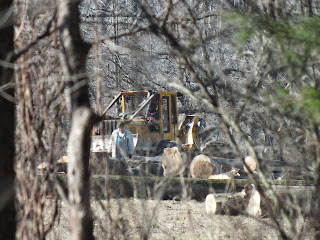This morning, as I worked in the kitchen, I noticed deer in the back hay field.
That was nothing unusual. We've seen groups of white tailed deer so often in the past months that I refer to them affectionately as, "the royal herd," as if, like times of old, they are the harts and hinds of our own little kingdom.
Sometimes I'll be going about my business in the house and I'll notice a deer will be standing right outside the window munching contentedly.
Other times I'll startle some as I round the corner of the barn.
There have been occasions when they stop in front of or next to our car
as we are going down the drive.
I've seen an eight point buck hop the board fence next to our house.
I've seen 2 different young bucks with asymmetrical antlers.
I've seen does with spindly legged fawns trailing behind.
I've seen does and yearlings bedded down in the field very near to the tree line.
And always, after they see me, they spring off after a bit of frozen indecision.
About 20 minutes after first taking note of the grazing deer, they caught my eye again, as I went about my tasks in the kitchen, because they had been startled. Their tails were up and they were bounding across the ground, zig zagging, with the occasional high leap for good measure. I didn't think much of it. It's a common sight in the early morning or late evening. I figured a dog had strayed over from a neighboring farm and was having some fun, but more deer emerged from the woods by the lake, so out of habit, I began to count them. After all, a royal inventory is always in order :)
I got to 6, was about to return to the task at hand, and then a small yearling streaked out of the woods as fast as it could go, and behind it came two coyotes. They soon stopped short, either afraid of the wide open space, or because they knew that their ambush had failed and there was little chance of catching the deer now.
At first I was mesmerized by the scene. I called out to my family that coyotes were in the field and had been chasing deer. We all gawked at them from various windows. They lingered a bit, pacing in frustrated circles, and then slunk back into the woods surrounding the lake.
 |
| Sorry, I didn't manage to take a picture of the coyotes, so you get a gratuitous picture of our lake. |
Later, after the morning was nearly over, I was remembering the sensational scene that had played out before me. Then I got to thinking that the coyotes came out of the "island" of woods around lake. The lake and surrounding woods are surrounded by hay fields. They hadn't even come out of the trees that are adjacent to hundreds of acres of woodland. They came from the small and seemingly innocuous woods in which we camped this fall (only to be waked several times in the night by a hair-raising scream that we thought was a bobcat or a mountain lion.)
The lake that we spent half of the day next to yesterday while we worked to clear the dam of trees and brush since it had been neglected for several years...
while our children played near us in the brush and in the lower barn.
That got me to start thinking about the possible danger to my children that coyotes might pose. The coyotes had been, after all, on the hunt at eight o'clock in the morning. Already I fear daytime encounters with copperheads and timber rattlers.
My children go out in tall rubber boots with instructions to step onto logs and then down, instead of simply stepping over them, to never reach under a log or into a hole or cave without prodding it first with a good, long stick. They have been instructed about how to tell pit vipers from non-venomous snakes. This is because copperheads and rattlers live around here, and we've seen lots of snakes- even inside our garage on the steps up into the house! (They have all been harmless and relatively small so far.)

I have also been mildly leery of letting my children camp in their own tent, as they want to do, because of the very small danger of an encounter with a bobcat or mountain lion. (Both have been sighted and confirmed by authorities to be in our part of our state, although they are certainly rare.) Now I had the daylight sighting of the coyotes to grapple with too. "Probably the odds of danger from coyotes is lower than with the wildcats," I thought. I did a quick internet search on coyotes. My first "hit" said this:
“Coyote attacks on humans and pets have increased within the past 5 years in California. Forty-eight such attacks on children and adults were verified from 1998 through 2003, compared to 41 attacks during the period 1988 through 1997...”
“Out of the 89 coyote attacks in California, 56 of the attacks caused injury to one or more people. Out of those that caused injury, 55% were attacks on adults. In 35 incidents, where coyotes stalked or attacked small children, the possibility of serous or fatal injury seemed likely if the child had not been rescued.” (Coyote Attacks: An Increasing Suburban Problem, Timm and Baker ’04)
In fact there have been 2 fatalities, a 3 year old who was playing untended in her front yard, and a 2 year old who was taken off of her front porch! But that was in California. Other than pets and livestock (a lot of livestock!) being killed by coyotes in my state, there have been no reports of coyotes attacking humans yet.

So I probably won't spend a lot of time worrying about a coyote encounter, especially since I already have so many other things to worry about. I console myself with the thought that more folks die from bee stings or lightning each year. (Although my closest neighbors DO keep bees...) But I probably will talk to my husband about fortifying the livestock fence, because I also read this:
"Coyotes use their front paws on the top of a fence and use their hind legs to propel themselves over a barrier. Your fence should be at least 5 to 6 feet tall and made of brick, cement blocks, wood or net -- wire is recommended. Add extenders to the top of the fence that extend outward 15 to 20” to prevent the coyote from climbing the fence. Or you can use coyote rollers along the top of the fence that keep coyotes and other wildlife from gripping the top of the fence to climb it."
"Coyotes are good diggers and often will dig under fences. To prevent digging, securely attach a 4 to 6 foot wire apron to the bottom of the fence. Electric fences can also be used to prevent coyote intrusion. Electric trip wires can be used at the base of the fence or a foot or two out to prevent digging as well." -http://www.desertusa.com/june96/cycot_qa.html
(And it's not like we have anything else to do... she types with heavy sarcasm.)


















































